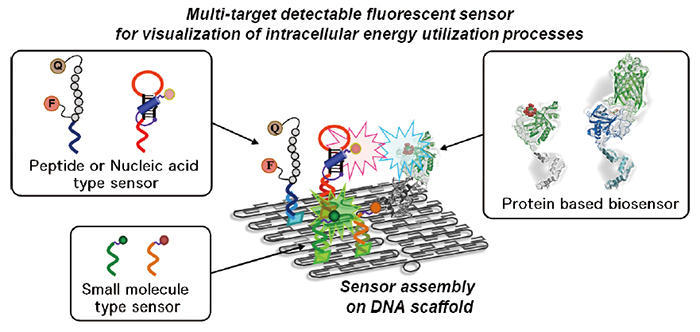Biomolecular Organization Chemistry
Advanced Energy Utilization Division Biomolecular Organization Chemistry Research Section
Professor : Eiji NAKATA
Our research group is exploring the design and the construction of biomacromolecules "tailored" for pursuing highly efficient energy utilization.
http://www.iae.kyoto-u.ac.jp/material/index-En.html
A design principle of functional biomolecules for highly effective energy utilization
A transition to renewable energy technologies requires new chemistry to learn from nature. It is our challenge to understand the efficient bioenergetic processes of nature and to construct human-engineered energy utilization systems. The research interests in our group focus on the design and assembly of biomacromolecules for energy conversion, catalysis and signal transduction in water, the solvent of life.
We take synthetic, organic chemical, biochemical and biophysical approaches to understand the biological molecular recognition and chemical reactions. Combination of protein including enzyme, nucleic acids, artificial molecules and their complex are explored to construct artificial biomimetic devices mimicking the function of biological systems and imaging cellular signals by fluorescent biosensors. New biomolecular assemblies are designed to realize artificial metabolic systems for useful chemicals.
Nanoassembly of enzymes and receptors to realize artificial metabolic systems
Cellular chemical transformation processes take place in several reaction steps, with multiple enzymes cooperating in specific fashion to catalyze sequential steps of chemical transformations. One is the most popular natural system is photosynthesis system. Such natural systems are effectively reconstructed in vitro when the individual enzymes are placed in their correct relative orientations.
DNA nano-structure such as DNA-origami can be used as "molecular switchboards" to arrange enzymes and other proteins with nanometer- scale precision. A new method was developed based on proteins, to locate specific proteins by means of special "adapters" known as DNA binding proteins. Several different adapters carrying different proteins can bind independently to defined locations on this type of nanostructure. By using the system, nanoassembly of enzymes and receptors will be constructed as the multi-enzymatic reaction system to realize artificial metabolic systems.
Construction of intracellular fluorescent sensors to visualize energy utilization processes in living cell.
Fluorescent sensor for visualizing metabolic reactions, which are the energy utilization processes of living cells, are constructed using synthetic chemistry or genetic engineering methods to advance the understanding of energy utilization processes in cells. In particular, we will construct multi-target detectable sensors, which can simultaneously monitor the change in concentration and location of biologically important molecules and the change in cellular environment indicated by various physical parameters will provide a comprehensive understanding of the molecular mechanisms underlying various cellular processes.










